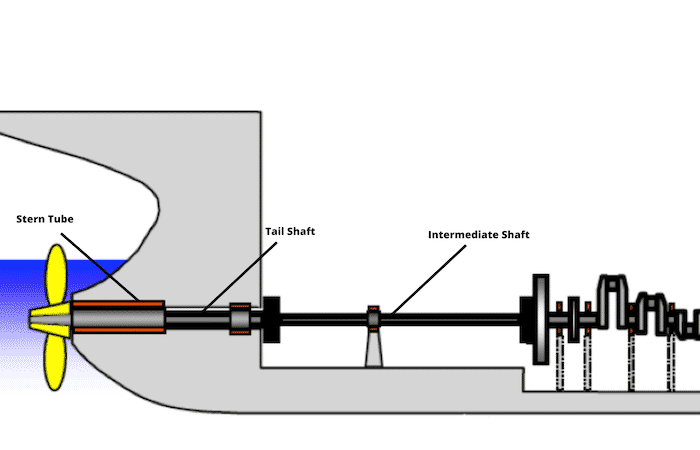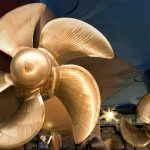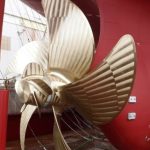The ship engine is connected to the propeller via different shafts connected together, which can be named as:
1. Thrust Shaft
2. Intermediate Shaft
3. Tail Shaft
Thrust shaft:
The crankshaft of the engine is first connected to the thrust shaft which passes through the thrust bearing whose main function is to transfer the thrust to the ship’s structure. The casing of the thrust bearing is similar in construction to that of main engine bedplate and the bearing is lubricated by main engine lubrication system oil. The material of the thrust shaft is usually solid forged ingot steel.
Intermediate Shaft:
The thrust shaft is then connected to a long intermediate shaft which comes in parts and joined together using solid forged couplings. The length and number of intermediate shaft joined together depends on the location of the main engine as a larger ship will have more distance between the main engine and the propeller. The material of the intermediate shaft is usually solid forged ingot steel.
Tail Shaft:
The Tail shaft, as the name suggests, is the end part of the shafting arrangement and carries the propeller. The tail shaft itself is carried on a lubricated stern tube bearing with seals as it connects and protrudes out of the ship’s engine room into the open sea, carrying the propeller.
The lubrication system can be of oil-based or water type. The tail shaft transmits the engine power and motion drive to the propeller. The material of the tail shaft is usually high strength duplex stainless steel alloy.
Reason for Heavy Running of Propeller
A propeller is supplied with engine power to rotate and propel the ship in the desired direction. If the amount of power provided to the propeller is not generating the same rate of revolution, the propeller is considered to be in a heavy running state which may be due to the following reason:
· Damage to propeller blades
· Increase in hull resistance due to hull fouling resulting in a change in wakefield
· During rough / heavy seas
· Ship sailing against the current
· Ship sailing in light ballast condition
· Ship Sailing In Shallow Water
· Ship with a flat stern


